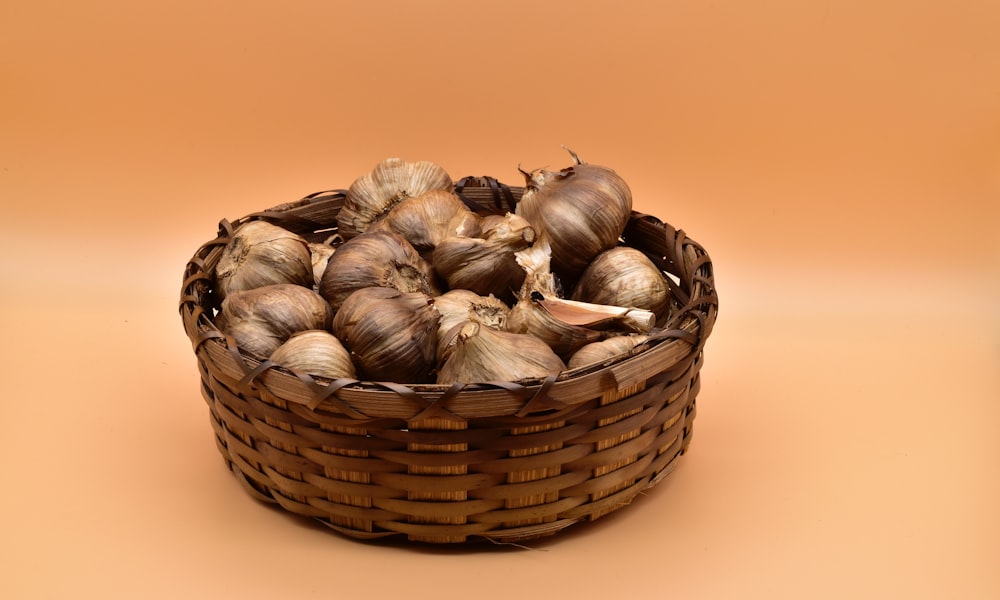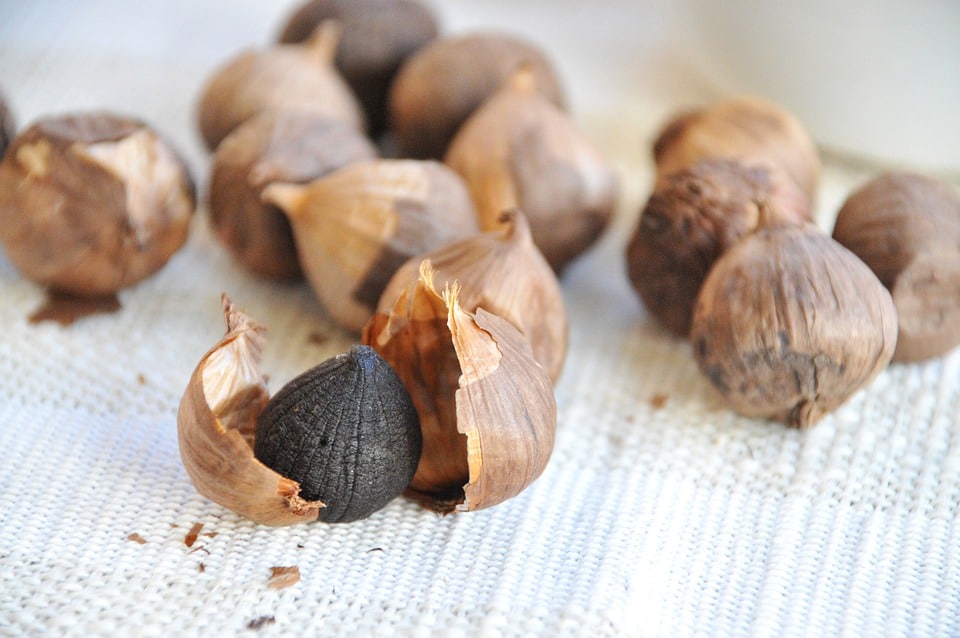Updated on November 11th, 2022
If you’re wondering, what does black garlic taste like? Well, it has an intense, complex flavor. It is chewy and has a pronounced bitterness and sweetness, with a powerful umami kick. It has hints of aged balsamic, leather, smoke, and tamarind, and it is considered a luxury good. It’s a versatile spice that can be added to any dish, from salads to soups.

It’s worth noting that black garlic does not have a strong smell, and yet it has an intense, complex taste that’s hard to describe in a few words. Its unique texture and flavor resemble those of chocolate, figs, pears, and a subtle smokiness. Its color comes from a fermentation process, which breaks down the sugars and amino acids in the garlic.
What is Black Garlic?
Black garlic is fresh, white garlic that has been aged for an extended period (often a month or more) by warming the garlic bulbs at about 140 to 190 F in high humidity until the cloves become tender and black in color.
Under the same conditions, some black garlic is aged by yeast fermentation. The Maillard reaction occurs when heat causes changes in the amino acids and sugars in garlic cloves during the aging process. Black garlic gets its rich, tangy, molasses-like flavor and black color from this reaction.
(It’s a common misconception that black garlic is fermented; it isn’t.) Fermentation, defined as the chemical breakdown of a substance by bacteria, yeasts, or microorganisms, is a standard process in producing foods such as sauerkraut and beer. The Maillard reaction, on the other hand, is responsible for the changes in color and flavor that occur in white garlic when it is turned into black garlic.)
What Does Black Garlic Taste Like?
Black garlic does not have much odor. It has a very complex and mysterious flavor. It has a soft, chewy texture and a rich aroma. The taste is sweet and sour, with hints of caramel and chocolate. When grilled or cooked for a few minutes, it’s best to ensure a rich flavor. It’s best to cook it until it’s tender and then remove it.
Black garlic has a tangy flavor similar to tamarind or balsamic vinegar and a mild sweetness that tastes like rich molasses with the complexity and umami notes of soy sauce.
Its cloves are softer and stickier than fresh garlic. The cloves dry slightly during the aging process, resulting in a slightly chewy but tender texture.
Is Black Garlic Good for you?
Garlic’s inherent health benefits are simply amplified and improved by the fermentation and aging process, according to Czerwony. On the other hand, patients on blood thinners should be cautious about incorporating black garlic into their diet, according to Czerwony.
“Garlic thins the blood a little more if you’re on blood thinners.” “But if you’re not allergic to it and don’t have any type of blood clotting disorder, I’ve found those are the only drawbacks,” Czerwony says.
Black garlic has a wide range of health benefits.
Improves the Health of the Brain
Because we know that inflammation in the brain can impair memory and worsen brain function over time, black garlic can help with overall brain health. “Some scientists discovered a compound linked to Alzheimer’s disease. They believe that if we could reduce brain inflammation, this compound would be less prevalent, lowering the risk of people developing Alzheimer’s,” says Czerwony.
There are more Antioxidants in this Product
Antioxidants are compounds that shield your cells from free radical damage (molecules that play a role in many conditions like heart disease or cancer). As a result of the fermentation process, black garlic contains two to three times more antioxidants than raw garlic. “When we look at antioxidants, we’re protecting your cells from oxidative damage,” Czerwony explains. “Some studies even suggest it has anti-cancer properties and could protect your liver from damage,” says the author.
It Aids in Blood Sugar Regulation
High blood sugar (hyperglycemia) can result in serious complications such as heart disease, kidney failure, and nerve damage, whereas low blood sugar (hypoglycemia) can result in seizures, fainting, and death. Blood sugar levels out of whack can lead to or exacerbate diabetes complications, but studies show that black garlic can help regulate blood sugar levels. “Some black garlic contains a probiotic that aids in preventing gestational diabetes,” Czerwony explains. “Perhaps this will help you curb your appetite and lower your blood sugar levels. When your blood sugar is lower, your chances of developing diabetes complications are lower.”
Heart Disease Risk is Reduced
Black garlic can lower LDL “bad” cholesterol and raise HDL “good” cholesterol in the body. As a result, inflammation in your heart and arteries can be reduced while blood flow increases. “Overall, it will help you improve your lipid profile,” Czerwony says.
Roasted Garlic vs. Black Garlic
The terms “roasted garlic” and “black garlic” are not interchangeable.
As previously stated, black garlic is created by allowing garlic cloves to rest for weeks at a time over low heat. Roasted garlic is made by baking garlic at a high temperature for about an hour or until it is very soft.
Tender and petite sticky, black garlic cloves are firm enough to slice or mince. They’re also slightly tangy and sweet, with savory, mild hints of the fresh garlic used in their preparation.
Garlic cloves that have been roasted have a sweet, caramelized flavor. They’re mushy and tender and easy to incorporate into salad dressings and mashed potatoes.
Is Black Garlic Sweet or Savory? Does Black Garlic have a Burnt Flavor?
Black garlic has a more robust flavor than white garlic, and it’s frequently used in sauces, dressings, and other dishes that need a boost.
Because black garlic is fermented at high temperatures for more extended periods, it lacks the sulfurous bitterness found in regular garlic. This results in sweeter flavors that aren’t as sharp on the tongue.
People prefer black garlic to other types of garlic because it tastes better.
A chemical reaction known as the Maillard reaction produces flavor, and garlic does not contain any additives or preservatives.
Is Black Garlic Expensive to Purchase?
The production of black garlic can take up to four months, significantly increasing the cost. The increased cost of black garlic, on the other hand, is well worth it because of the flavor and health benefits. The extra cost of Black Garlic is well worth it in the long run!
Black garlic is a healthier alternative to foods high in sodium or fat. We should pay more for more nutritious foods because eating a healthy diet is essential for our health. The cost of black garlic varies depending on where you live, and it costs more than regular garlic, but the health benefits and flavor make it well worth the money.
What is the Best Way to Store Black Garlic?
Unpeeled black garlic bulbs can be stored whole in their packaging at room temperature until ready to use. Once opened, store the package in the refrigerator until the best-by or use-by date has passed. In the refrigerator, black garlic can last up to one month.
Black garlic cloves, whole or diced, and purees should be stored in the refrigerator in airtight containers or glass jars and used by the date indicated on the packaging.
Other varieties (such as granulated black garlic) should be stored according to package directions. Still, in general, they should be kept in an airtight container or jar in an excellent, dry location.
How to Use Black Garlic?
- This substance does not have a strong smell or flavor, making it an excellent addition to recipes requiring minimal ingredients. It is an excellent addition to pasta dishes and other sauces. You can make a flavored tomato paste with black or white garlic.
- There are several different flavors of black garlic, so it’s difficult to describe its exact flavor without tasting it. Regardless of the type of garlic, you’re eating, black garlic has a unique taste. You can also find it in various cooking oils, such as ketchup and mustard.
- When you’re cooking with black garlic, you’ll want to look for multi-clove garlic. The multi-clove garlic is a common form of garlic, but black clove garlic has no cloves, and the skins are separated by the cloves. The solo clove garlic is smaller and rounder, with no skin separation.
- After sautéing it with some onion, chop it up and combine it with olive tapenade.
- For dipping bread, mince it and combine it with olive oil and sea salt.
- It can be mashed into potatoes, hummus, and other dips.
Conclusion
There are two types of black garlic. It comes in whole bulbs and as single cloves. A multi-clove garlic is a round, oval garlic with multiple cloves, while a single clove is a round, single clove with no skin. Both have a slightly sweet, creamy flavor, which makes them perfect for cooking. They’re not the same, but they have similar properties. They are similar in size and have a similar flavor to white garlic, and can be used in the same way.
The flavor of black garlic is not very strong, and it is softer than raw garlic, and it’s often used as a replacement for regular garlic in most recipes. It’s great on a cheese pizza, and salads adding add a tangy, slightly sweet flavor. In general, black-garlic can be substituted for regular-sized garlic in most recipes, and it can be used in a similar manner as its raw counterpart.

